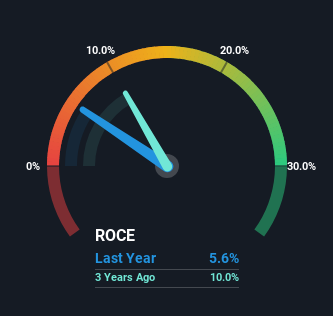- Singapore
- /
- Marine and Shipping
- /
- SGX:D8DU
We Like These Underlying Return On Capital Trends At First Ship Lease Trust (SGX:D8DU)

There are a few key trends to look for if we want to identify the next multi-bagger. Ideally, a business will show two trends; firstly a growing return on capital employed (ROCE) and secondly, an increasing amount of capital employed. This shows us that it's a compounding machine, able to continually reinvest its earnings back into the business and generate higher returns. So on that note, First Ship Lease Trust (SGX:D8DU) looks quite promising in regards to its trends of return on capital.
Return On Capital Employed (ROCE): What Is It?
For those who don't know, ROCE is a measure of a company's yearly pre-tax profit (its return), relative to the capital employed in the business. To calculate this metric for First Ship Lease Trust, this is the formula:
Return on Capital Employed = Earnings Before Interest and Tax (EBIT) ÷ (Total Assets - Current Liabilities)
0.056 = US$3.5m ÷ (US$66m - US$4.3m) (Based on the trailing twelve months to December 2023).
So, First Ship Lease Trust has an ROCE of 5.6%. On its own, that's a low figure but it's around the 6.9% average generated by the Shipping industry.
Check out our latest analysis for First Ship Lease Trust

While the past is not representative of the future, it can be helpful to know how a company has performed historically, which is why we have this chart above. If you'd like to look at how First Ship Lease Trust has performed in the past in other metrics, you can view this free graph of First Ship Lease Trust's past earnings, revenue and cash flow.
The Trend Of ROCE
First Ship Lease Trust has not disappointed in regards to ROCE growth. The figures show that over the last five years, returns on capital have grown by 43%. That's not bad because this tells for every dollar invested (capital employed), the company is increasing the amount earned from that dollar. Speaking of capital employed, the company is actually utilizing 74% less than it was five years ago, which can be indicative of a business that's improving its efficiency. A business that's shrinking its asset base like this isn't usually typical of a soon to be multi-bagger company.
In Conclusion...
From what we've seen above, First Ship Lease Trust has managed to increase it's returns on capital all the while reducing it's capital base. And with the stock having performed exceptionally well over the last five years, these patterns are being accounted for by investors. So given the stock has proven it has promising trends, it's worth researching the company further to see if these trends are likely to persist.
Since virtually every company faces some risks, it's worth knowing what they are, and we've spotted 3 warning signs for First Ship Lease Trust (of which 2 don't sit too well with us!) that you should know about.
While First Ship Lease Trust isn't earning the highest return, check out this free list of companies that are earning high returns on equity with solid balance sheets.
New: AI Stock Screener & Alerts
Our new AI Stock Screener scans the market every day to uncover opportunities.
• Dividend Powerhouses (3%+ Yield)
• Undervalued Small Caps with Insider Buying
• High growth Tech and AI Companies
Or build your own from over 50 metrics.
Have feedback on this article? Concerned about the content? Get in touch with us directly. Alternatively, email editorial-team (at) simplywallst.com.
This article by Simply Wall St is general in nature. We provide commentary based on historical data and analyst forecasts only using an unbiased methodology and our articles are not intended to be financial advice. It does not constitute a recommendation to buy or sell any stock, and does not take account of your objectives, or your financial situation. We aim to bring you long-term focused analysis driven by fundamental data. Note that our analysis may not factor in the latest price-sensitive company announcements or qualitative material. Simply Wall St has no position in any stocks mentioned.
About SGX:D8DU
First Ship Lease Trust
A business trust, owns a fleet of product tankers in Europe.
Flawless balance sheet with solid track record.
Market Insights
Community Narratives




